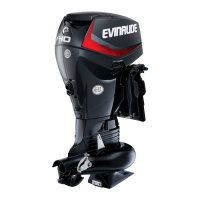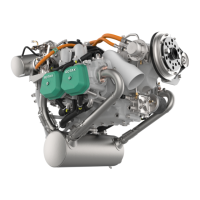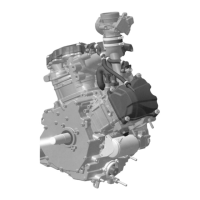101
ELECTRICAL AND IGNITION
STATOR TESTS
6
STATOR TESTS
The stator consists of 3 windings (4 poles each)
on a 5 inch diameter core and generates an out-
put voltage of 55 VAC (1100 watts maximum).
This voltage is converted by the EMM to provide
12 VDC for battery charging (3 to 5 A at 500 RPM
and 25 A from 3000 RPM to WOT) and 55 VDC
for fuel injector, and fuel and oil pump operation.
Stator Resistance Tests
Use a digital multimeter to check resistance of sta-
tor windings.
Disconnect EMM J2 connector from EMM.
Connect meter leads to the following pins:
• Yellow/white and yellow (pins 9 and 1)
• Brown/white and brown (pins 10 and 2)
• Orange/white and orange (pins 11 and 3)
IMPORTANT: A reading of less than 2 ohms is
acceptable. Make sure meter is calibrated to read
1 ohm or less.
To check for a grounded winding, connect one
meter lead to ground and alternately connect the
other meter lead to each stator wire. Meter should
read no continuity. If meter reads continuity,
replace stator.
Stator Voltage Output Test
ELECTRIC START MODELS
Use a digital multimeter to check stator output
voltage. Set meter to read 110 VAC output.
Disconnect CPS.
Disconnect stator (6-pin) connector from the
engine harness (6-pin) connector.
Connect Stator Test Adaptor tool, P/N 5005799, to
stator connector.
Connect meter leads to terminals of adaptor tool.
With a fully charged battery, crank outboard (300
RPM minimum) and observe meter reading:
• 30 VAC at 300 RPM
• 40 VAC at 400 RPM
• 55 VAC above 500 RPM
Stator Winding Resistance Specification
Yellow & Yellow / white
.670 ± 0.020 Ω @ 73°F (23°C)
Brown & Brown / white
.670 ± 0.020 Ω @ 73°F (23°C)
Orange & Orange / white
.670 ± 0.020 Ω @ 73°F (23°C)
1. EMM J2 Connector 002462
A WARNING
To prevent accidental starting of outboard,
disconnect crankshaft position sensor
(CPS).
1. Stator Test Adaptor 002396

